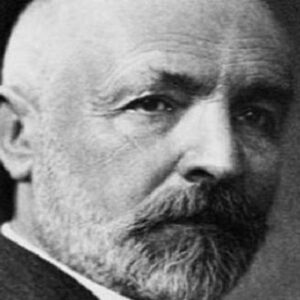Georg Cantor, a renowned German mathematician, is credited with discovering and establishing a hierarchy of infinite sets based on their cardinal numbers. He is also credited with inventing the Cantor set, which has since become a foundational concept in mathematics. Born into a musical family, he demonstrated an early aptitude for music. He also excelled academically, with a particular affinity for mathematics. He earned a bachelor’s degree from the University of Berlin, where he studied physics, philosophy, and mathematics before embarking on a successful academic career. Although many of his contemporaries strongly opposed Cantor’s views on certain mathematical topics, he resisted their criticism and continued his research. Apart from his contributions to the study of cardinal numbers, Georg Cantor is credited with advancing the study of trigonometry and transfinite numbers. Furthermore, he established the critical nature of one-to-one correspondence in set theory. He suffered from mental illness in his later years, but remained active in mathematical endeavors. He was presented with the Sylvester Medal, the highest honor in mathematics. Cantor was also passionate about music and the arts. Cantor was said to be a spiritual person who believed that God communicated with him some of his mathematical discoveries.
Childhood & Adolescence
Georg Ferdinand Ludwig Philipp Cantor was born in Saint Petersburg, Russia, on March 3, 1845. His parents were Georg Waldemar Cantor and Maria Anna Bohm. His father was a Protestant from Germany, and his mother was a Roman Catholic from Russia. Cantor was raised as a devout Protestant and inherited his parents’ passion for the arts.
Cantor had a private tutor from an early age and attended a St. Petersburg primary school. Cantor’s family moved to Germany in 1856, when he was 11 years old, although Cantor was never at ease in this country.
He was a brilliant student and graduated with honors from Darmstadt’s Realschule in 1860. He excelled at mathematics, especially trigonometry.
In 1862, he enrolled at the University of Zürich. Meanwhile, his father passed away, leaving him a sizable inheritance. Thus, in 1863, the young Cantor transferred to Berlin’s University of Berlin, where he attended lectures by Leopold Kronecker, Karl Weierstrass, and Ernst Kummer. He specialized in physics, philosophy, and mathematics during his time there.
He then spent a semester at Göttingen University in 1866 and completed his doctoral thesis in 1867.
Career of Georg
Georg Cantor began his career by briefly teaching in a Berlin girls’ school. He then accepted a position at Halle University, where he spent the remainder of his career. He began as a lecturer in 1869 and was promoted to assistant professor and full professor in 1872 and 1879.
Between 1869 and 1873, he published a series of ten papers on the theory of numbers. Heinrich Eduard Heine, a colleague, recognized Cantor’s ability and encouraged him to pursue research in the theory of trigonometric series.
He built on recent work by German mathematician Bernhard Riemann on trigonometric series to demonstrate that the function of a complex variable can be represented in only one way by a trigonometric series.
In 1874, he began work on what became known as set theory. Cantor’s correspondence with Richard Dedekind, a mathematics professor at the Brunswick Technical Institute, sparked ideas about set theory in his mind.
He published an article titled ‘On a Property of the Collection of All Real Algebraic Numbers’ in 1874, which established set theory as a branch of mathematics. The article provided a rigorous demonstration that there were multiple types of infinity. He established through this work that real numbers are not countable.
In multiple ways, the article was seminal. Additionally, it contained a novel method for constructing transcendental numbers, which Joseph Liouville invented in 1844.
Extending his research, between 1879 and 1884, he published a series of six articles in ‘Mathematische Annalen’ that served as an introduction to his set theory. During this time period, he also introduced the Cantor set.
During this time period, he received harsh criticism for his works, which is believed to have had an effect on his mental health, despite the fact that he continued to work on mathematics despite the criticism.
He published his “diagonal argument” for the existence of an uncountable set in 1891. He used the same concept to establish what is now called Cantor’s theorem. The theorem states that for any set A, the set of all its subsets has a cardinality that is strictly greater than A.
By this time, his mental health had deteriorated, despite his determination to conduct mathematical research. His final significant contributions to set theory were published in 1895 and 1897 in ‘Mathematische Annalen’, edited by Felix Klein.
Significant Works of Georg
Georg Cantor founded set theory, a subfield of mathematical logic devoted to the study of sets. Although this theory is most frequently applied to mathematical objects, any type of object can be collected into a set.
In 1874, he also introduced a new method for constructing transcendental numbers, which had been constructed previously by Joseph Liouville in 1844.
Awards and Accomplishments
In 1904, the Royal Society presented Cantor with the Sylvester Medal, the highest honor the society can bestow for work in mathematics.
Personal History and Legacies
In 1874, Georg Cantor married Vally Guttmann. Their marriage was happy, and they had six children. He was prone to bouts of depression and struggled with mental illness in his later years. His final years were spent in abject poverty, and he spent his final year in a sanatorium. He was assassinated on January 6, 1918. The Deutsche Mathematiker-Vereinigung established the Georg Cantor Medal in his honor.
Estimated Net Worth
The net worth of Georg is unknown.


